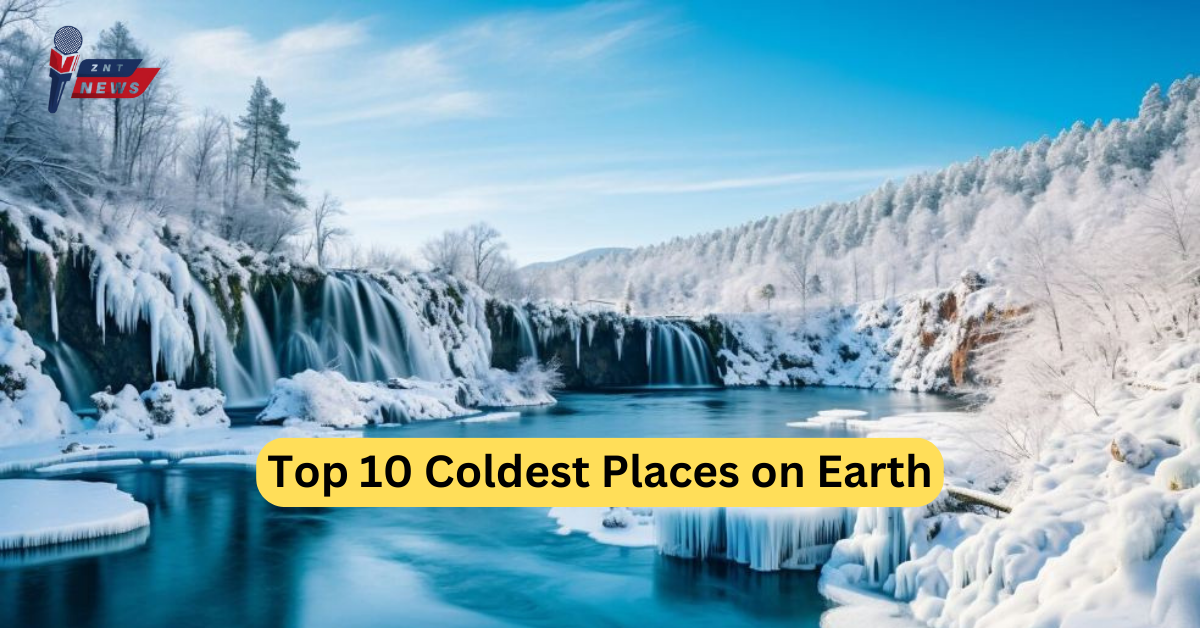Top 10 Coldest Places on Earth: Venturing into the frigid extremes of our planet requires more than just courage; it demands proper preparation. In this bone-chilling journey, we’ll uncover the ten coldest places on Earth, where temperatures plummet to unimaginable lows. While these locations may be inhospitable for human habitation, they serve as vital grounds for groundbreaking scientific research. So, grab a warm cup of cocoa as we embark on a frosty expedition to the world’s most freezing locales.
List of Top 10 Coldest Places on Earth

Snag, Yukon, Canada (Temperature: -62.7°C – February 1947):
Nestled in a bowl-shaped valley, the now-abandoned village of Snag witnessed a record low temperature during an anomalous winter in the 1940s. Locals reported surreal scenes of breath freezing mid-air and falling as a white dust, while sounds carried unusually far in the dense cold air.
North Ice, Greenland (Temperature: -66.1°C – January 1954):
Established in 1952 by the British North Greenland Expedition, North Ice served as a research station reached initially by dog sledges. In 1954, it recorded the coldest temperature in the northern hemisphere, triggering comprehensive research in geology, seismology, physiology, and glaciology.
Oymyakon, Russia (Temperature: -67.8°C – February 1933):
Regarded as one of the coldest permanently inhabited settlements, Oymyakon, with its less than 1,000 residents, endures extreme conditions intensified by valleys trapping cold winds. The local schools reportedly only close when temperatures drop below an astonishing -55°C.
Klinck Research Station, Greenland (Temperature: -69.4°C – December 1991):
Situated on the vast ice-covered expanse of Greenland, the Klinck Research Station braves the worst of the dry, cold continental climate. Scientists, equipped with snowmobiles and instruments, conduct critical climate research in this inhospitable environment.
Verkhoyansk, Russia (Temperature: -69.8°C – February 1892):
As one of the northern ‘Poles of Cold,’ Verkhoyansk experiences unique climate dynamics driven by the Siberian High. This town of approximately 1,000 inhabitants witnesses remarkable temperature fluctuations, with summer temperatures exceeding 30°C.
Denali, Alaska (Temperature: -73.8°C – Between 1950 and 1969):
Formerly known as Mount McKinley, Denali, the highest peak in North America, hosted a weather station near its summit, recording the coldest temperature in the United States in 2003 at -73.8°C.
Dome Argus, Antarctic Plateau (Temperature: -82.5°C – July 2005):
Situated near Dome Fuji, Dome Argus is speculated to harbor the coldest natural conditions on Earth. Researchers have identified regions where temperatures could plunge below -90°C, making it a potential contender for the coldest place on the planet.
Amundsen-Scott South Pole Station, Antarctica (Temperature: -82.8°C – June 1982):
Perched on the Antarctic plateau, this station, with its average population of around 150, experiences temperatures that rarely climb above -12°C even in summer. Scientists at the station engage in diverse research, from neutrinos to biomedical studies.
Vostok Research Station, Antarctica (Temperature: -89.2°C – July 1983):
Established by the Soviet Union in 1957, Vostok Research Station records the lowest mean annual temperature of any weather station on Earth. It boasts more than 22 hours of sunlight in December and has revealed hidden subglacial ecosystems through explorations into Lake Vostok.
Dome Fuji, Antarctic (Temperature: -93.2°C – August 2010):
In 2010, Dome Fuji claimed the title of the coldest place on Earth with a bone-chilling temperature of -93.2°C, surpassing the previous record at Vostok. Despite its extreme conditions, humans have established the Dome Fuji Station, offering insights into paleo-climatic history through ice core drilling.
Conclusion:
As we conclude our journey through the coldest corners of the world, it’s evident that these extreme environments, while forbidding, play a crucial role in advancing our understanding of climate, geology, and the limits of human adaptation. Whether it’s the abandoned village of Snag or the frosty expanse of Dome Fuji, these places stand as testaments to both the harshness of nature and the resilience of scientific exploration. So, if you ever plan to visit these icy realms, don’t forget to pack more than just a coat – pack a sense of awe for the wonders that lie within the frozen landscapes.
………………………By ZNT News
